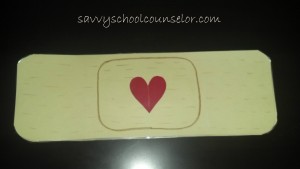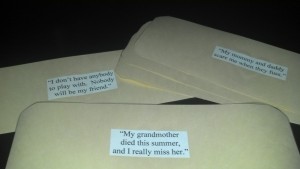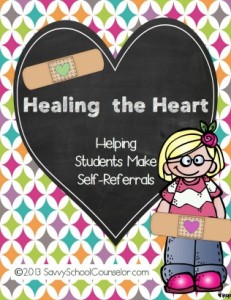A Bandage For Your Heart
 Hello all! After a busy last week of summer vacation, I finally started back to work on Friday, August 17. I was so excited to move BACK into my guidance office from the much smaller office I used last year. While cleaning out one of the drawers in my file cabinet, I came across another lesson I’ve used for discussing when students should see the school counselor. I want to share it with you today.
Hello all! After a busy last week of summer vacation, I finally started back to work on Friday, August 17. I was so excited to move BACK into my guidance office from the much smaller office I used last year. While cleaning out one of the drawers in my file cabinet, I came across another lesson I’ve used for discussing when students should see the school counselor. I want to share it with you today.
The activity is called A Bandage for Your Heart. To make the bandages, I used manila paper. I cut them 18 inches by 6 inches. I used a brown crayon to draw the “look” of the bandage. I cut small red hearts using construction paper. On the opposite side of each bandage, I added some sentences giving some reasons students may want to complete a self-referral form to see me.
There are eight bandages which have the following sentences:
- My grandmother died this summer, and I really miss her.
- My daddy is sick all the time, and he never plays with me anymore.
- There’s somebody who showed me a knife at school and told me I better not tell.
- My mommy and daddy scare me when they fuss.
- There’s somebody on the bus who keeps picking on me and hitting me.
- I don’t have anybody to play with. Nobody will be my friend.
- I got a trophy at my soccer match last Saturday.
- It’s my birthday, and I’m so happy!
Use the last two statements to give examples of non-urgent situations that do not require an appointment with the school counselor. Explain that you definitely want to hear good news from them, but an individual counseling session just for that purpose isn’t necessary.
Also, you’ll want to wear a bandage on your shirt close to your heart. If no one asks why it’s there, ask the students if they noticed anything when you came in the room. From there, begin to share and explain each of the bandages. Many times, I would talk about different sized rocks to help explain urgent vs. non-urgent referrals. A big rock is urgent, and students might need to see you on the same day. A medium rock means it’s important, but the counselor can see you sometime that week. A small rock is something you want to talk about, but you can wait until the following week to see the counselor if necessary. If you use this to assist with your discussion, have the students share examples of what they think a small, medium, or large rock would be. This is also a great time to show students what the form looks like, where to find it, how to complete it, and where to return it.
Check out this Self-Referral Activity in my TpT store if you’d like to use this activity with your students.
Stick around! You can follow Savvy School Counselor with free email updates. As always, I’d love to hear from you. How do you explain self-referrals to your students?






2 Comments
Tanya
I like how you use the different rock sizes to explain small-medium-big problems and their urgency. I often use a backpack during my first introduction lesson, and while I’m telling students about the kinds of issues I help students with, I put a rock into the backpack. When the backpack is full, I have a student come up and put the backpack on (or they tell me, “No way! It’s too heavy!”) and then I talk about how coming to see the counselor is like “lightening their load”. As they talk about their concerns, it’s like taking rocks out of their backpack and they can leave feeling lighter and more able to cope with their day’s (life’s) struggles. I will definitely be using the SIZE of the rocks in the backpack to explain the urgency of problems to see me for! Thanks!
Vanessa
Great idea, Tanya! Thanks for sharing the backpack idea.